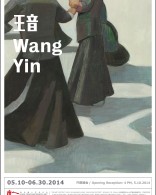Tang Contemporary Art Center proudly presents the opening of Wang Yin’s solo exhibition on Saturday, May 10, 2014. The exhibition will include Wang Yin’s newest works from 2009 – 2014, showcasing his creative process and methodology for the first time over the past few years.
In a modern culture that sees constant “farewell” as ideology, the revisit of earlier Chinese predecessors’ oil paintings makes the thread of Wang’s works clear but complicated. In his works, we see that his issues involve the power relation between Chinese folk painting and academic painting, the spiritual connection between Soviet painting and Soviet culture, Soviet painting and the cultural context of our fathers’ generation, the mutual viewing of the frontier theme and modern awareness, and the political association of liberation in Yan’An Art. The various factors in the painting system entangle and impede one another to be the history of Chinese contemporary art. But in his work, he never acts as a speaker, and there is no implication or amplification in the pictures. Instead, he exposes or presents them by creating connections. Thus, revisiting the earlier Chinese predecessors ‘ oil paintings is meaningful for him in the sense that he is rooted in where he grows rather than reinterpreting history.
—— ShuKewen
To summarize, Wang Yin attempts to reveal the ‘accent’ of painting. He attempts to make all the objects within his painting more challenging, and he can only use this method of ‘stuttering’ to paint. Subsequently, he can only maintain a distance from the seamless forms of painting, the painting that is inseparably connected to the contemporary, and also the trajectory of the fast-paced present era. But what does this distance away from the present-era signify? It is perhaps another kind of contemporaneity. It is more so a separation from the era, and furthermore a form of being contemporary. So what is contemporaneity? At this point we can conclude using a quote from Agamben: “Contemporaneity refers to a particular way of connecting to your own era, this kind of connection is already intrinsically a part of the era, whilst at the same time, there is also a distance maintained. To be more precise, the connections to the present era are either defined by relationships between the fractures and mistakes or they adhere to the present era. Those entirely at consensus with the era, those who are completely connected with all aspects of an era, they are the people who are not truly contemporary. The precise reason behind this is that they cannot truly scrutinize it – they cannot just rigidly gaze at it.” Perhaps precisely for reasons that he departs from contemporary mainstream painting, Wang Yin’s paintings possess a greater notion of contemporaneity.
——Wang Min’an
The normal form in the history of artistic styles and the subject matter in the social history of art always represent an affiliation that covers each other. Wang Yin’s job is to tear them apart, reviving their discourses through forcing them to separate from their natural status, and then grafting them with each other with their genealogies of discourses. As a result, we have seen many examples of folding art histories, such as the Picinairism and ethnic subject matter, human bodies, still objects and landscapes, self-portraits and plaster figures. From ruffle and rupture of the discourse stratum raised by them, painting released its internal energy. Wang Yin also applied this kind of process, which requires opening experiences by constant wrapping and assembling, on him. He keeps re-creating previous paintings and self-referencing constantly, so that mangos, woman bodies and even a kind of special green are spread onto the field of painting. In a word, every painting of Wang Yin can not only regarded as critiques for each time he paints, but also an introspection to the history of art and readjustment of self- painting experiences.
——Bao Dong



